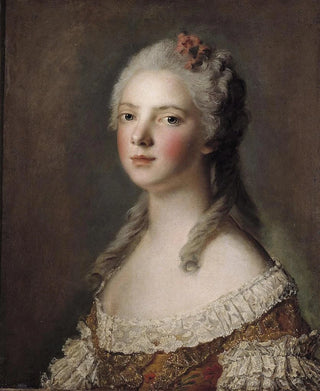Art print | Portrait of Marie-Adélaïde of France, daughter of Louis XV, known as Madame Adélaïde - Jean-Marc Nattier


View from behind

Frame (optional)
Portrait of Marie-Adélaïde of France, daughter of Louis XV, known as Madame Adélaïde - Jean-Marc Nattier – Captivating introduction
The portrait of Marie-Adélaïde of France, created by Jean-Marc Nattier, embodies the elegance and refinement of the 18th century. This artwork, which depicts the daughter of Louis XV, is much more than a simple image; it is an open window to an era when the court of Versailles shimmered with splendor. Through the gaze of this princess, the viewer is transported into a universe where beauty and power intertwine. Every detail of this composition, from the sumptuous drapery to the delicate accessories, testifies to Nattier's mastered artistry, who knows how to capture the very essence of his subjects. Gazing at this portrait, one feels a connection with history, an invitation to discover the intrigues and passions that animated court life.
Style and uniqueness of the work
Nattier's style is distinguished by his ability to blend realism and idealization. In this piece, he succeeds in portraying Marie-Adélaïde with palpable grace, while embellishing her features to make them even more enchanting. The colors, carefully chosen, reveal a soft and harmonious palette, evoking the delicacy of femininity. The drapery of her dress, beautifully rendered, seems almost alive, creating an impression of movement and fluidity. Nattier excels in the art of light, playing with shadows to give depth to his subject and the background. This approach gives the portrait a depth that invites exploration. In short, the work is a perfect example of the Rococo style, where exuberance and lightness intertwine to give life to an idealized vision of nobility.
The artist and his influence
Jean-Marc Nattier, an emblematic figure of the 18th century, established himself as one of the most sought-after portraitists of his time. Trained in the shadow of masters such as François Boucher, he developed a distinctive style that combines finesse and sophistication. Nattier was able to capture the spirit of the era, responding to the expectations of an aristocracy in search of

Matte finish

View from behind

Frame (optional)
Portrait of Marie-Adélaïde of France, daughter of Louis XV, known as Madame Adélaïde - Jean-Marc Nattier – Captivating introduction
The portrait of Marie-Adélaïde of France, created by Jean-Marc Nattier, embodies the elegance and refinement of the 18th century. This artwork, which depicts the daughter of Louis XV, is much more than a simple image; it is an open window to an era when the court of Versailles shimmered with splendor. Through the gaze of this princess, the viewer is transported into a universe where beauty and power intertwine. Every detail of this composition, from the sumptuous drapery to the delicate accessories, testifies to Nattier's mastered artistry, who knows how to capture the very essence of his subjects. Gazing at this portrait, one feels a connection with history, an invitation to discover the intrigues and passions that animated court life.
Style and uniqueness of the work
Nattier's style is distinguished by his ability to blend realism and idealization. In this piece, he succeeds in portraying Marie-Adélaïde with palpable grace, while embellishing her features to make them even more enchanting. The colors, carefully chosen, reveal a soft and harmonious palette, evoking the delicacy of femininity. The drapery of her dress, beautifully rendered, seems almost alive, creating an impression of movement and fluidity. Nattier excels in the art of light, playing with shadows to give depth to his subject and the background. This approach gives the portrait a depth that invites exploration. In short, the work is a perfect example of the Rococo style, where exuberance and lightness intertwine to give life to an idealized vision of nobility.
The artist and his influence
Jean-Marc Nattier, an emblematic figure of the 18th century, established himself as one of the most sought-after portraitists of his time. Trained in the shadow of masters such as François Boucher, he developed a distinctive style that combines finesse and sophistication. Nattier was able to capture the spirit of the era, responding to the expectations of an aristocracy in search of






